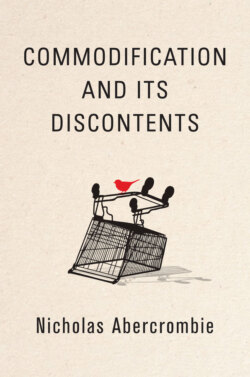Читать книгу Commodification and Its Discontents - Nicholas Abercrombie - Страница 13
Law, Land and Property
ОглавлениеThere is a conventional account of land ownership and the law that goes with it that suggests a radical change took place between medieval conceptions of the use and control of land and a later notion of absolute property that developed slowly from the fourteenth century onwards (Linklater, 2015). A ‘landscape of rights and customs’ was replaced by ‘a landscape of private property’ (Williamson and Bellamy, 1987: 102). In the early Middle Ages, farmers had customary rights to the land that they worked, but they also had obligations to their lord. Gradually, however, these relationships changed so that large landowners had contractual relationships with their tenant farmers rather than customary ones and a class of larger farmers emerged who had ownership of the land that they worked. The large landowners saw themselves as absolute owners mainly, though not entirely, free to do what they liked with their land and were less constrained by customary obligation. Such a view of land ownership was, of course, contested by landless farmers and farm labourers over a very long period, mainly with a view to installing a system of peasant proprietorship. A different form of this ideological argument became prominent in the later nineteenth century, organized around the possibility of the nationalization of land promoted by followers of Henry George (Douglas, 1976; Tichelar, 2018b). No less a figure than J. S. Mill notably argued that: ‘No man made the land. It is the original inheritance of the entire species.’ People should only own what it is that they create. There can therefore be no private property in land, only in its produce. For Mill, therefore, one possibility is that ‘the State might be the universal landlord, and the cultivators tenants under it’ (Mill, 1978: 94, 96). Since then, this movement has helped to create a different view of property in land.
Legal textbooks warn against an intuitive or everyday understanding of land law in England. By that is meant a notion of land as a physical presence whose ownership is absolute; either one has ownership of a piece of land or one does not. Land ownership, however, is not a question of a physical object; it is rather an issue of control over use. The ownership of property in land is best conceived as a set of rights of control some of which may be legally exercised by an owner but others of which may be held by some other person, or institution. Land may not be unique in this respect but its complexity is unusual. For example, a nominal landowner may cede rights of control to others by leasing or licensing. In leasing, a tenant is granted exclusive possession for a fixed term in exchange for a payment. But there are a bewildering number of varieties of this arrangement. Similarly, licenses can vary from a simple permission to be on someone’s land to a more proprietorial interest. Or the extent of a landowner’s control may be circumscribed by restrictive covenants or by devices such as easements, rent charges, mortgage charges or rights of entry. However, in modern times, by far the most significant cause of restriction on property rights arises out of the activities of the state, especially in planning legislation and environmental protection. Gray and Gray (2007: 420) argue that the contemporary view of property law is in stark contrast with the absolutist view of earlier times:
With their ringing assertions of ‘property absolutism’, the great judges of the Victorian era acknowledged no overriding duty on the part of the private landowner to safeguard wider interests in the exploitation of his land. The estate owner remained free to utilise ‘his’ land selfishly with little or no regard for community concerns or environmental sensitivities.
And they conclude:
The role of government in the regulation of land use … is now so pervasive that ‘property’ in land is often said to have taken on the character of a kind of social stewardship … ‘Property’ can therefore be conceptualised as involving – on a vast scale – the distribution by the state of user rights which are heavily conditioned and delimited by the public interest … On this view, ‘property’ in land comprises not so much a ‘bundle of rights’, but rather a form of delegated responsibility for land as a valuable community resource. (Gray and Gray, 2007: 55)
Restrictions, by the state, on property rights in the name of the collective interest are an intervention in the market for land and constitute resistance to commodification. How, then, did this increased role for the state come about?
